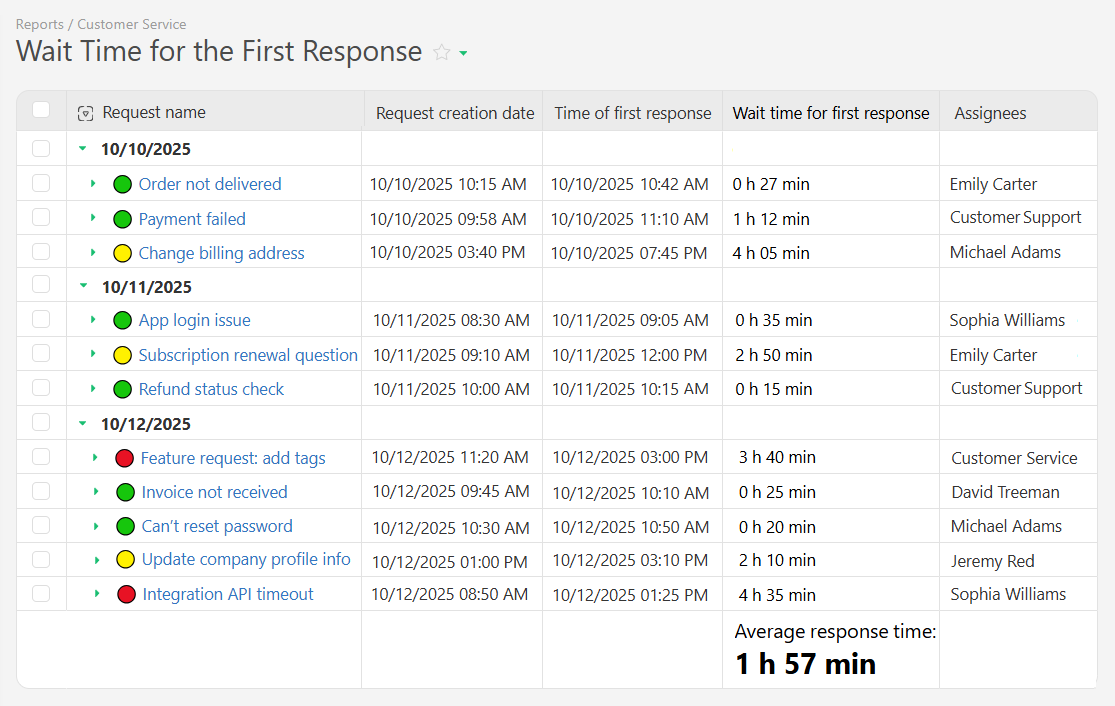
- Why SLAs Matter For Everyday Team Workflows
- The Meaning of SLA, SLO, and OLA (and Why the Distinction Helps)
- What SLA Tracking Looks Like in a Task Management Platform
- Common SLA Types in Task Management (and How They Behave)
- Implementing SLA Tracking Step by Step
- Examples You Can Adapt Without Creating Noise
- Best Practices That Stand Up Under Load
- Pitfalls That Sabotage the Program
- How SLA Tracking Fits into the Rest of the Workspace
- Conclusion
SLA tracking in task management means turning service promises into measurable targets and then monitoring every task against those targets. Instead of saying “as soon as possible,” you define exactly what “good” looks like (for example, first response within two business hours and resolution within eight business hours) and you let the system start, pause, and stop the clock automatically.
In practice, SLA tracking is less about the timer and more about accountability. The platform records the key events, warns you before a breach, escalates when necessary, and summarizes performance in Reports and Dashboards. That creates a common language for customers, internal stakeholders, and managers: everyone understands what is expected and when.
Why SLAs Matter For Everyday Team Workflows
SLAs make work predictable. Customers get timely acknowledgment and resolution, and teams know which tasks deserve attention first. By agreeing to service levels ahead of time, you eliminate ambiguity during busy periods and protect focus when multiple requests arrive at once.
There is also a coaching benefit. When targets are explicit and measured the same way for everyone, managers can help individuals improve without guessing. Trends in compliance shed light on structural issues (perhaps the night shift is understaffed, or a product area consistently generates cases that exceed resolution targets) and the conversation shifts from anecdotes to data.
The Meaning of SLA, SLO, and OLA (and Why the Distinction Helps)
People often ask for a service level agreement definition when they really want three definitions. The SLA is the documented promise to a customer or stakeholder. It explains what level of service you will deliver and what happens when you fall short. The SLO (service level objective) is the numeric target that proves you met the promise, such as “90% of P2 tickets resolved within two business days.”
The OLA (operational level agreement) lives inside your organization. It is the internal commitment that supports the external promise (for example, the platform team agrees to respond to an escalation within thirty minutes). In a task tool, SLA tracking mostly enforces SLOs, but it also helps demonstrate that OLAs are being respected. Keeping these terms separate prevents you from enforcing the wrong target in the wrong place.
What SLA Tracking Looks Like in a Task Management Platform
On the surface, SLA tracking shows up as timers on tasks and colored states: on track, at risk, breached. Underneath that simple view are several design choices you make once and then rely on every day. First, you describe policies that bind targets to scope: which Projects and queues are covered, which priorities matter, and who owns the outcome. Second, you attach those policies to business calendars so the system counts only working hours, honors holidays, and respects time zones.
A third piece is event logic. You define start, stop, and pause events in plain terms your team recognizes. For instance, the first-response clock might start when a task is created and stop on the first agent reply visible to the requester. The resolution clock might start when the task enters a tracked status and stop when the status changes to Done/Resolved. Pauses are deliberate states such as “waiting for customer” or “waiting for vendor,” and they should be visible in reports so they don’t become hiding places for stuck work.

Policy Components You Actually Need
A workable policy has five ingredients. It states the scope (which tasks it governs) and the targets (response, resolution, update frequency). It specifies the calendar and time zone. It lists the events that start, pause, and stop the timer. And it names the escalation path: who is notified as a breach approaches and what the system should do when it happens. You can add exceptions for legal holds or third-party dependencies, but resist the temptation to encode every edge case. A small, well-understood policy set performs better than a sprawling catalog nobody can reason about.
Policies are not only for external customers. Internal stakeholders benefit from promises too. A product team that receives urgent bug reports might set a first-response target on high-priority defects and an update-frequency target for longer investigations. The same mechanics apply, and the same dashboards show whether the agreement is working.
Calendars and Time Zones
If your platform measures in real time while your customer lives in another time zone, your numbers will mislead you. Always connect SLA policies to business calendars so the timer breathes with your working day. A “two-hour first response” is two business hours, not two wall-clock hours at 02:00. If you serve multiple regions, attach the correct calendar to each project or queue and surface the active time zone on the task.
Holidays and exceptional days deserve attention as well. Keep calendars updated, or you will see false breaches during national holidays or planned shutdowns. When teams operate in hybrid patterns (some on-site, some remote) agree on the reference calendar up front and document it inside the policy.
Start, Stop, and Pause Events
Timers must align with how people work, not with how we wish they worked. Define start events that are automatic and unambiguous, such as “task created” or “status entered.” Define stop events that match visible outcomes: “first agent reply sent” or “status moved to Resolved.” Then write pause rules explicitly. “We thought it paused” is how noisy programs are born. If you allow a “waiting for customer” state, make it easy to exit, and report how long tasks spend there over time.
Edge cases are where clarity pays off. Decide what happens on reopen. Will the original resolution timer resume, or will a new one start? Either choice can be correct, but inconsistency across queues guarantees arguments and skewed data.
Escalations and notifications
Escalation should help a human solve a problem, not flood them with alarms. Near-breach alerts go to the assignee and team lead with the remaining time and one suggested action. Breach alerts may go to a duty manager and can trigger Automations that add watchers, change priority, or reroute the task. Keep messages short and precise so people learn to trust the signal.
Silence can be as harmful as noise. Review alerting rules after every significant incident. If responders ignored a message, ask whether the content was vague, the recipient the wrong person, or the timing unhelpful. Tweaking these details maintains credibility without rewriting the whole policy.
Reporting and Dashboards
SLA tracking pays for itself in Reports. Beyond overall compliance, look at percentile time to first response and resolution by hour, by queue, and by assignee. Break down backlog aging to see where work quietly stalls. Then bring the numbers to Dashboards so leaders can watch health at a glance and line managers can drill down to individual tasks.
The highest value comes from pairing SLA results with staffing and arrival patterns. If breaches cluster at specific hours, your schedule (not your people) may be the bottleneck. If one queue hits targets comfortably while another struggles, the difference could be case mix rather than effort.
Common SLA Types in Task Management (and How They Behave)
Most teams begin with first response and resolution timers. The first measures the time to a meaningful human reply; the second measures the time to a defined end state. Long-running work often needs an update frequency target, which ensures the assignee posts progress at agreed intervals even when resolution is far away.
Incident response adds a time to engage metric that tracks how quickly a qualified person starts working. High-priority queues sometimes add an acknowledgement target distinct from first response, just to confirm someone is actively triaging the case. Each timer requires precise start, stop, and pause rules so you can compare apples to apples across teams.
Implementing SLA Tracking Step by Step
Start with an inventory of task types, priorities, and queues you actually handle today. For each, write a one-sentence outcome and translate it into an SLO. For example: “P1 incidents: 95% acknowledged within 15 minutes; 85% resolved within four business hours.” Then encode those targets in a policy and bind the policy to the correct scope – specific Projects, queues, or labels.
Before you go live, configure business calendars and test start/stop/pause events with real tasks. A one-week pilot is a good investment. During the pilot, pay more attention to near-breach warnings than to aggregate compliance; you want to prove that the right people see the right signals early enough to act. Adjust pause rules and escalation paths while the blast radius is small.
After the pilot, connect the data to reports and a simple Dashboard. Schedule a monthly review with the teams who own these targets. Treat the first month as a calibration period: do not lower targets too quickly, but avoid punishing teams for historical backlogs. The goal is an agreement that feels fair when the queue is quiet and protective when the queue spikes.
Examples You Can Adapt Without Creating Noise
A pragmatic baseline covers most needs without overwhelming anyone. Track first response on all inbound customer tasks so no request disappears. Track resolution on defects and incidents so your quality bar is visible. Track update frequency on projects that span more than a week so stakeholders hear from you even when progress is incremental.
Tighten targets for P1/P2 work and relax them for P3/P4. If you serve multiple geographies, create region-specific calendars and attach them to the relevant queues. When you depend on vendors, allow the timer to pause in a “waiting for vendor” state, and make that state visible in Reports so it does not become a black hole. For incidents, add an escalation matrix and let Automations bring senior help when a breach occurs.
Best Practices That Stand Up Under Load
The best SLAs are simple enough that the whole team can explain them. Keep the catalog short; avoid loops and nested conditions that make timers unpredictable. Tie every policy to clear ownership so unassigned tasks are treated as a risk, not as an orphan. Document pause rules in plain language and audit them; a policy nobody reads is a policy nobody follows.
When tasks reopen, decide what happens to the resolution timer and apply that choice consistently. Use Time Tracking to compare calendar time with effort hours; long calendar times with low effort often mean misrouted work or unclear ownership. Above all, treat SLA data as an instrument panel. If one person carries the breach burden month after month, look at staffing and tooling before you jump to conclusions about performance.
Pitfalls That Sabotage the Program
Skipping calendars is the fastest way to create noise. Your numbers will look worse than reality, and trust in the system will erode. Priority inflation is another classic failure; when everything becomes P1, nothing is. Time-zone blindness produces unfair measurements for global teams. And stop-the-clock abuse (pausing without scrutiny) masks real problems. Make pause states visible, limited, and reviewed.
Data quality matters too. If statuses, transitions, and custom fields are inconsistent, timers will start and stop at the wrong moments, and your Reports will mislead. Before you chase exotic features, fix the basics and keep them fixed.
How SLA Tracking Fits into the Rest of the Workspace
SLA policies touch almost everything. Task creation determines priority and queue. Notifications carry the countdown and breach alerts. Automations add watchers, change priority, or reroute tasks to a specialist team. Reports and Dashboards show compliance and trends. Time Tracking helps you compare effort with calendar time. Even access control matters because escalations must reach people who can act. The cleaner these pieces connect, the less manual shepherding the team needs.
SLA tracking also improves cross-team coordination. When everyone sees the same timers and definitions, hand-offs become predictable. A task does not just “move”; it changes state with a clear consequence for the clock. That makes collaboration calmer and outcomes easier to forecast.
Conclusion
If you want SLAs to drive real outcomes, keep the catalog small, bind each policy to business hours, and define start, stop, and pause events unambiguously. Wire near-breach and breach notifications to the right owners, surface compliance in Reports and Dashboards, and use Time Tracking to compare resolution effort with calendar time across Projects and Tasks. Run a short pilot, fix edge cases, then review monthly to retire noisy rules, tune thresholds, and close loopholes around pause states and priorities.
Done this way, SLA tracking becomes a quiet system that protects customers and teams alike. You replace vague promises with a predictable commitment you can measure, improve, and confidently keep and the day-to-day experience of work becomes more transparent, more humane, and easier to scale.


Thanks for this clear explanation. SLA tracking really helps turn promises into measurable actions, keeping both teams and customers aligned.